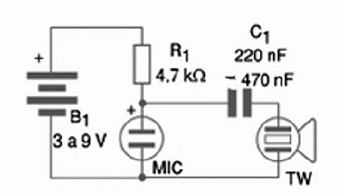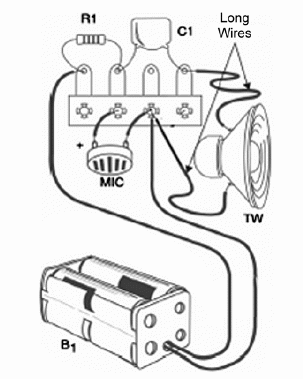Note: this project was included in my book Science Fair and Technology Education Projects published in USA.
The wires can be extended up to 100 m, without expressive loss in performance. The transducers are piezoelectric tweeters or small phone transducers. Since the project does not use an amplifier stage, the audio level is very low.
The transducer can be placed very near to the ear to give good results. The circuit is powered from common AA cells or a battery, and because its power drain is very low, the battery life can be extended. Figure 1 shows the schematics for the communicator.

TW1 can be a piezoelectric tweeter without the internal transformer or a ceramic transducer. In the case of a tweeter, connect the wires directly to the ceramic transducer.
Figure 2 shows the final aspect of the circuit, assembled on a terminal strip.

When assembling, it is very important to observe the position of the electret microphone and the cells. Any inversion and the circuit will not function.
The value of the resistor R1 must be found by test. Values between 1 k ohm and 10 k Ω must be tested until you find the best performance. An interesting application for this device is as a secret communication system to contact your friends as a private telephone.
MIC—Electret Microphone—two terminal
B1—3 to 9 V—AA cells with holder or 9 V battery, with connector
R1—4.7 k ohm x 1/8 W resistor (yellow, violet, red) - see previous text
C1—220 nF to 470 nF ceramic or polyester capacitor
TW—Piezoelectric tweeter or ceramic transducer
Other:
Terminal strip, wires, solder, etc.
Competition and Challenges:
1. Give a prize to the best assembly
2. Promote a competition to find the best technical explanation
3. Propose as challenge finding other practical applications for the circuit




